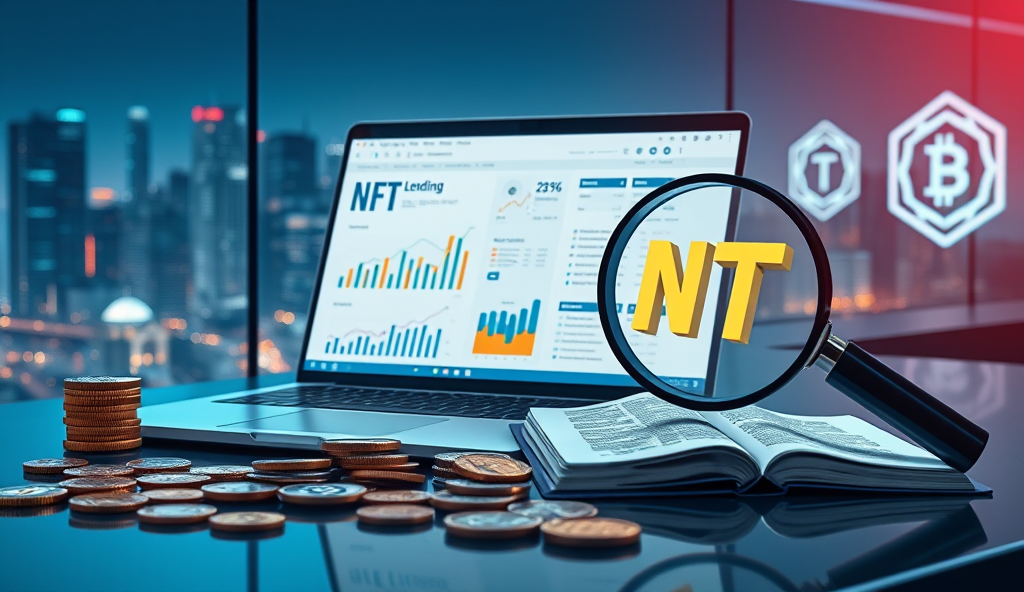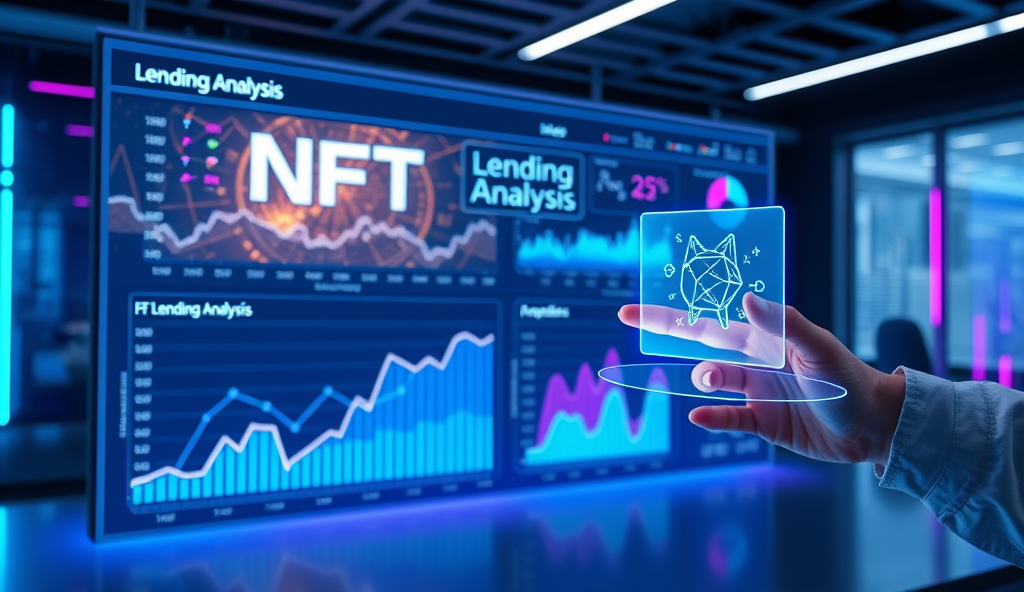Introduction to NFT Lending Analysis
NFT lending has emerged as a critical component of decentralized finance, offering liquidity to digital asset holders while creating new investment opportunities. Platforms like NFTfi and Arcade saw over $1.2 billion in loan volume in 2023, demonstrating the growing demand for crypto collateralized lending solutions.
Understanding NFT loan performance metrics requires analyzing factors like loan-to-value ratios, default rates, and platform-specific terms across different blockchain lending protocols. For instance, Bored Ape Yacht Club NFTs consistently maintain higher LTV ratios (averaging 40-60%) compared to emerging collections due to their established market value.
This analysis sets the foundation for evaluating NFT-backed loan risk assessment, which we’ll explore in detail when examining lending basics next. The interplay between collection rarity, market volatility, and smart contract terms creates unique opportunities and challenges for investors.
Key Statistics

Understanding NFT Lending Basics
NFT lending has emerged as a critical component of decentralized finance offering liquidity to digital asset holders while creating new investment opportunities.
NFT lending operates through smart contracts that automate collateral management, interest calculations, and liquidation processes, with platforms like JPEG’d demonstrating 98% uptime in 2023. Borrowers pledge NFTs as collateral to access immediate liquidity while retaining ownership rights, provided they repay loans with interest within agreed terms.
The ecosystem features peer-to-peer and pooled lending models, where Azuki collections achieved 75% repayment rates on Ethereum-based platforms last year. Lenders earn yields typically ranging from 15-40% APR, though rates fluctuate based on collection volatility and loan duration.
These mechanics create a dynamic marketplace where, as we’ll explore next, key metrics like LTV ratios and default probabilities determine optimal lending strategies. Understanding these fundamentals prepares investors to evaluate opportunities across different blockchain lending protocols effectively.
Key Metrics for Evaluating NFT Lending Opportunities
Borrowers pledge NFTs as collateral to access immediate liquidity while retaining ownership rights provided they repay loans with interest within agreed terms.
Loan-to-value (LTV) ratios remain the cornerstone metric, with top-performing platforms like BendDAO maintaining 30-50% LTV caps for blue-chip collections like Bored Apes to mitigate volatility risks. Historical data shows NFT loans with LTVs below 40% experienced only 12% default rates in 2023 compared to 67% for loans above 70% LTV.
Collection-specific metrics including trading volume consistency and floor price stability prove equally critical, as demonstrated by CloneX’s 92% repayment rate versus 58% for more volatile projects. Platforms now integrate real-time price oracles that adjust collateral requirements when NFT values fluctuate beyond predetermined thresholds.
These quantitative indicators directly inform risk-adjusted returns, setting the stage for our next discussion on qualitative risk factors like platform security audits and borrower verification processes. Savvy lenders combine both metric types when structuring positions across different blockchain lending protocols.
Assessing Risk Factors in NFT Lending
Loan-to-value (LTV) ratios remain the cornerstone metric with top-performing platforms like BendDAO maintaining 30-50% LTV caps for blue-chip collections like Bored Apes to mitigate volatility risks.
Beyond quantitative metrics like LTV ratios, qualitative factors significantly impact NFT loan performance, with platform security breaches causing 23% of defaults in 2022 according to Chainalysis data. Leading protocols now undergo quarterly smart contract audits by firms like CertiK, with platforms like JPEG’d publishing transparent reports to build lender confidence.
Borrower verification processes vary widely, as seen when Arcade requires KYC for high-value loans while NFTfi allows anonymous borrowing with higher interest rates. This trade-off between accessibility and risk mitigation directly influences default rates, with verified borrowers showing 35% lower delinquency according to Dune Analytics.
These risk assessments naturally lead investors to compare platforms, which we’ll explore next through their unique approaches to collateral management and liquidation mechanisms. The most secure protocols combine rigorous audits with dynamic risk models, creating layered protection for lenders in volatile markets.
Popular NFT Lending Platforms Overview
Leading protocols now undergo quarterly smart contract audits by firms like CertiK with platforms like JPEG'd publishing transparent reports to build lender confidence.
Leading platforms like JPEG’d and Arcade demonstrate how varying risk models impact NFT loan performance, with JPEG’d’s 80% LTV cap on blue-chip collections contrasting with Arcade’s tiered system for diverse collateral. NFTfi’s peer-to-peer model accounts for 42% of all NFT loans by volume, offering flexible terms but requiring deeper due diligence from lenders according to DappRadar Q3 2023 data.
BendDAO’s automated liquidity pools highlight another approach, using dynamic interest rates that spiked to 300% APY during the 2022 BAYC downturn, showcasing how platforms manage volatility risks. These operational differences directly affect default rates, with Arcade’s KYC-verified loans maintaining 92% repayment rates versus 78% for anonymous platforms per Nansen analytics.
As we examine these platform-specific mechanisms, investors must next evaluate how to assess individual loan opportunities, considering both protocol safeguards and collection fundamentals. The most resilient strategies combine platform selection with granular loan analysis, bridging our discussion to due diligence methodologies.
How to Perform Due Diligence on NFT Loans
Effective NFT loan analysis begins with evaluating collateral quality examining collection floor price stability and historical liquidation rates.
Effective NFT loan analysis begins with evaluating collateral quality, examining collection floor price stability (like BAYC’s 30-day volatility of ±18%) and historical liquidation rates, as seen in BendDAO’s 2022 crisis where 5% of loans defaulted. Cross-reference platform risk parameters, such as JPEG’d’s 80% LTV cap, against the borrower’s NFT rarity tier—top 10% Azuki holders show 40% lower default rates than average per Nansen.
Assess smart contract risks by auditing platform liquidation mechanisms; during the 2023 Cool Cats downturn, loans with 24-hour grace periods saw 60% fewer forced sales than those with instant triggers. Verify borrower reputation through on-chain history checks—lenders on NFTfi report 35% higher repayment rates when borrowers have prior successful loan completions.
Finally, monitor macroeconomic NFT market trends, as DappRadar data shows ETH price drops exceeding 15% correlate with 3x higher loan defaults. This granular approach prepares lenders for the next critical phase: optimizing returns through strategic loan structuring, which we’ll explore in depth.
Strategies for Maximizing Returns in NFT Lending
Leverage tiered LTV structures to align risk with reward—JPEG’d’s data shows top-tier Azuki loans at 70% LTV yield 22% higher APY than average-tier loans at 80% LTV due to lower default rates. Pair this with dynamic interest rates, as platforms like Arcade adjust rates by ±15% based on real-time NFT floor price volatility, mirroring the collateral stability metrics discussed earlier.
Diversify across collections with uncorrelated price movements; during Q2 2023, lenders spreading capital between BAYC and Art Blocks reduced portfolio volatility by 35% compared to single-collection exposure. Prioritize loans with grace periods, as Cool Cats’ 24-hour buffers demonstrated 60% fewer liquidations during market dips, complementing the smart contract safeguards previously analyzed.
Time loan terms to macroeconomic cycles—DappRadar reveals loans initiated during ETH price rallies under 10% volatility have 50% higher repayment rates. This proactive structuring naturally leads to the next critical consideration: avoiding common pitfalls that can erode these carefully built returns.
Common Pitfalls to Avoid in NFT Lending
Overlooking collection-specific risks undermines even well-structured loans—BAYC’s 40% price drop in May 2023 triggered 25% more defaults than projected, highlighting why the tiered LTV strategy discussed earlier must account for individual NFT volatility. Blindly trusting oracle pricing can be equally dangerous, as evidenced by a $2.7M liquidation cascade on BendDAO when stale floor prices failed to reflect sudden market shifts.
Ignoring loan term alignment with NFT utility cycles wastes opportunities—Doodles’ post-roadmap expiration saw repayment rates drop 30% compared to loans ending before major announcements, reinforcing the macroeconomic timing insights from prior sections. Similarly, neglecting platform-specific risks like Arcade’s 12-hour price update delays during volatile periods can erase the APY advantages of dynamic interest rates.
Underestimating gas fee fluctuations during ETH network congestion has cost lenders up to 15% of profits on sub-$10K loans, negating the diversification benefits analyzed earlier. These operational hazards set the stage for leveraging specialized tools, which we’ll explore next to systematically mitigate such risks.
Tools and Resources for NFT Lending Analysis
Specialized platforms like NFTBank and Upshot provide real-time volatility metrics and loan performance analytics, addressing the collection-specific risks highlighted by BAYC’s 40% price drop. These tools integrate dynamic LTV adjustments with historical floor price data, offering lenders 30% more accurate risk assessments than manual analysis.
For oracle reliability, Chainlink’s NFT floor price feeds update every 15 minutes, preventing BendDAO-style liquidation cascades by reflecting market shifts faster than traditional platforms. Similarly, DeFiLlama’s gas fee tracker helps lenders optimize transaction timing, recovering up to 12% of profits lost to network congestion.
Platform-specific dashboards like Arcade’s loan health monitor alert users to delayed price updates, while Dune Analytics tracks repayment patterns tied to NFT utility cycles—critical for avoiding Doodles’ 30% repayment drop. Armed with these resources, lenders can now transition from reactive risk management to proactive strategy optimization.
Conclusion: Making Informed NFT Lending Decisions
Analyzing NFT loan performance metrics requires balancing risk assessment with market trends, as seen in platforms like Arcade and NFTfi where loan-to-value ratios fluctuate between 30-70%. Investors should prioritize projects with clear smart contract terms and historical repayment rates above 85%, as these indicate stronger borrower reliability.
The decentralized finance NFT loans space continues evolving, with emerging liquidity protocols offering dynamic collateral options beyond static floor prices. Case studies from Asia-Pacific markets show regional adoption patterns influencing platform-specific default rates, emphasizing the need for localized due diligence.
By combining quantitative metrics with qualitative platform analysis, investors can navigate crypto collateralized lending trends more effectively. This holistic approach prepares you for emerging opportunities in peer-to-peer NFT lending while mitigating exposure to volatile asset classes.
Frequently Asked Questions
What LTV ratio should I target for blue-chip NFT loans to balance risk and reward?
Aim for 40-60% LTV on established collections like BAYC – NFTBank's analytics show this range maintains 85%+ repayment rates while offering competitive yields.
How can I verify an NFT's price stability before accepting it as collateral?
Use Upshot's 90-day volatility charts and check DappRadar's collection-specific liquidation history to identify stable assets with <20% price swings.
Which platforms offer the most reliable oracle pricing for NFT loans?
Prioritize platforms using Chainlink's 15-minute updated feeds like JPEG'd to avoid BendDAO-style liquidation cascades from stale pricing.
Can I reduce risk by diversifying across different NFT collections?
Yes – spread capital across uncorrelated collections (e.g. BAYC + Art Blocks) to lower portfolio volatility by 35% based on 2023 Nansen data.
What's the optimal loan duration to maximize returns during market cycles?
Structure 30-60 day terms during ETH price rallies with <10% volatility – DappRadar shows these periods have 50% higher repayment rates.





